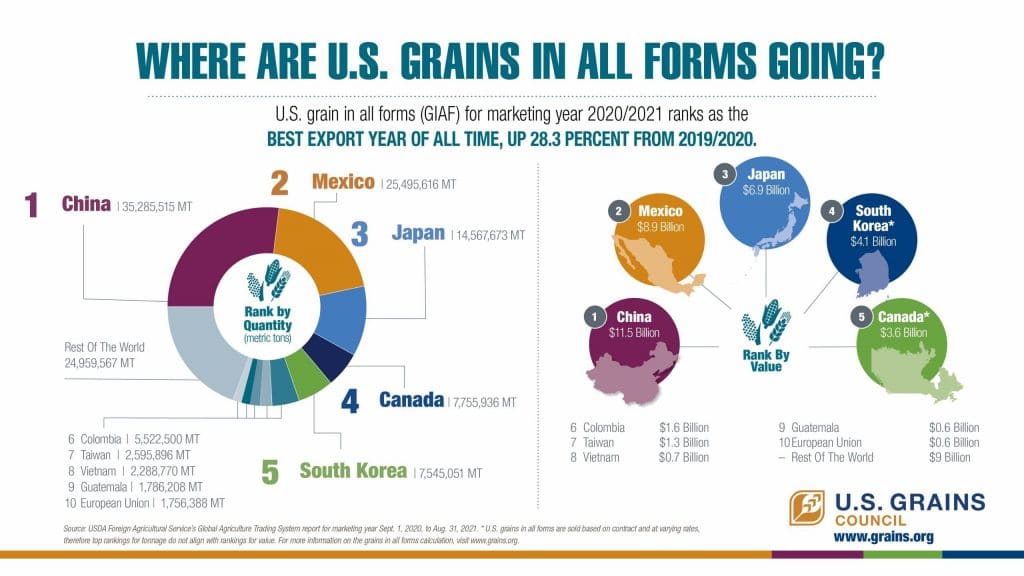U.S. exports of grains in all forms (GIAF) reached an all-time high during the 2020/2021 marketing year. Recovering from a two-year period of decline, exports rose by 28.3 percent, totaling 129.5 million metric tons (MMT), or 5.2 billion bushels, according to data from the U.S. Department of Agriculture (USDA) and analysis by the U.S. Grains Council (USGC).
To track GIAF exports, the Council reviews exports across 10 product sectors, including U.S. corn, barley and sorghum and value-added products including ethanol, distiller’s dried grains with solubles (DDGS) and other co-products, as well as the corn equivalent of exported meat products.
“Reaching an all-time high record for exports of grains in all forms while we continue to deal with a global pandemic shows the commitment of USGC members to continue to expand exports of grains in all forms as well as the dedication from USGC’s global staff to develop markets and increase market access for grains in all forms,” said Cary Sifferath, USGC senior director of global programs.
U.S. corn exports rose by 55 percent in 2020/2021 from the previous marketing year, totaling 69.8 MMT (2.7 billion bushels). China soared to record highs for U.S. corn imports, totaling over 21.4 MMT (845.2 million bushels) compared to 11.2 MMT (439.5 million bushels) in the previous marketing year. Notably, corn exports to South Korea rose 36 percent from the previous marketing year to 3.8 MMT (141.1 bushel), making it the fifth-largest market. Mexico experienced its third-largest year on record for corn exports at 15.5 MMT (631.8 bushels) in 2020/2021.
Another year of big sorghum sales to China helped offset losses from Mexico, Sudan and Japan, for a nearly 40 percent increase in overall U.S. sorghum exports year-over-year at 7.18 MMT (283 million bushels). China maintained its status as the top market, with imports doubling from last year for a total of 6.78 MMT (267.2 million bushels). Afghanistan imported U.S. sorghum for the first time on record, totaling 34,800 MT (1.3 million bushels), while Kenya and Cameroon saw substantial increases.
U.S. exports of barley and barley products increased by more than 56 percent in 2020/2021, totaling over 757,000 MT (34.7 million bushels) across 90 countries. Mexico had a record year, purchasing more than half (54.4%) of all U.S. barley and barley products exported at 412,000 MT (18.9 million bushels). Additionally, Canada, the second-largest market, set a new marketing year record, importing more than 310,700 MT (14.2 million bushels) of U.S. barley and barley products.
Driven by strong export gains in Mexico, Vietnam, Turkey and Canada, U.S. DDGS exports totaled more than 11.6 MMT in 2020/2021, up more than 10 percent from the previous marketing year. Mexico represented over 18 percent of all U.S. DDGS exports at 2.21 MMT. Additionally, Turkish purchases of U.S. DDGS rebounded significantly in 2020/2021, increasing by more than 55 percent to nearly 937,000 MT.
The lingering effects of COVID-19 stay-at-home orders were reflected in the global ethanol trade in the 2020/2021 marketing year; however, U.S. ethanol exports experienced its fifth-largest year on record, with exports totaling 1.22 billion gallons (434 million bushels). You can read more about the 2020/2021 U.S. ethanol exports here.
With the 2021/2022 marketing year in full swing, the Council will continue working around the world to promote the quality, reliability and value of U.S. coarse grain products, co-products and ethanol. Follow along with the Council as the organization tracks GIAF exports throughout the year with the Feed Grains In All Forms portal.
View all commodity-specific infographics for the 2020/2021 marketing year.
About The U.S. Grains Council
The U.S. Grains Council develops export markets for U.S. barley, corn, sorghum and related products including distiller’s dried grains with solubles (DDGS) and ethanol. With full-time presence in 28 locations, the Council operates programs in more than 50 countries and the European Union. The Council believes exports are vital to global economic development and to U.S. agriculture’s profitability. Detailed information about the Council and its programs is online at www.grains.org.

